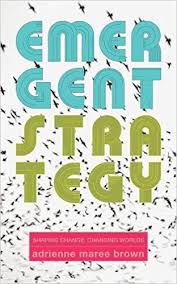Feeling The Living Agenda
Feeling The Living Agenda
By: Justin Laing | January 28, 2019 | What Are We Working On
 The last section of adrienne maree brown’s Emergent Strategies: Shaping Change, Changing Worlds is a series of facilitation tools. One of these tools I used recently is “the living agenda”, a way of building an agenda at the beginning of a gathering by asking people what are the topics they’d like to discuss over the period of time they are together and then organizing them so that they serve as the gathering’s agenda. I used this tool for a recent two day gathering in concert with a prepared agenda and I really liked the way the two agendas complemented each other.
The last section of adrienne maree brown’s Emergent Strategies: Shaping Change, Changing Worlds is a series of facilitation tools. One of these tools I used recently is “the living agenda”, a way of building an agenda at the beginning of a gathering by asking people what are the topics they’d like to discuss over the period of time they are together and then organizing them so that they serve as the gathering’s agenda. I used this tool for a recent two day gathering in concert with a prepared agenda and I really liked the way the two agendas complemented each other.
The initial agenda had been prepared in conversation with one of the members of the group and so served as a foundation for the gathering, but we both wanted to be sure that the full group had more of an opportunity to weigh in (time in advance being what it was) so the first item on the prepared agenda was “review agenda”, but we did this much expansively than I usually do with such an item. Using an exercise described in this last section of the book, I asked people to place post-its on the wall noting the issues or questions they wanted to be sure we addressed over the course of the two days. We then went to group the topics and see if they would be covered in the agenda that was already developed. This part was confusing because the post-its i selected were too small and I had not given direction to use 6 words or less and print clearly, so they would be both legible and easy to grasp. Lesson learned there. However, we were able to suss out that a cluster of the ideas offered us a significantly different philosophical reason for not only the purpose of the two days, but the purpose of the group overall. This was fascinating. Yet, the idea that we would change the agenda to accommodate this new discussion was a little disconcerting for the group at first because it meant another pre-selected topic might not get discussed (I am not in favor of lengthening days “to get it all done”). And yet the ensuing conversation brought a real a-ha moment about how we looked at the work and the group’s overall purpose.
The 45 minutes or so we used to review the pre-determined agenda with the living agenda process then helped add an agenda item, but more importantly it helped the group members communicate its priorities to one another. This in turn created a plan for this year in which an area that really mattered to some members of the group will now receive strategic intention in a way it otherwise might not have received. It also opened up communications about why some of the group may have different kinds of priorities and how this may be related to all kinds of structural issues of power and access. I’ll definitely use this approach again.
